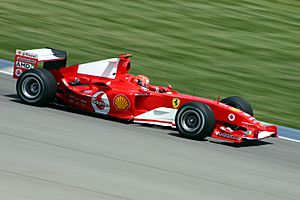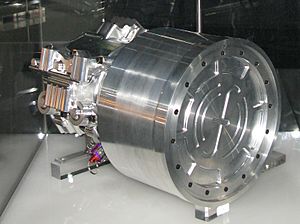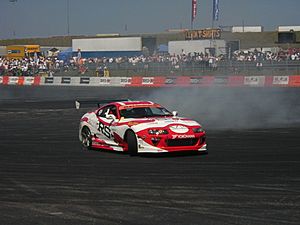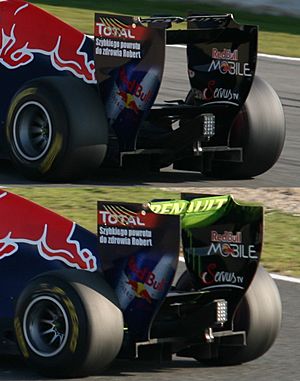Formula One car facts for kids
A Formula One car is a special racing car. It is used in Formula One races. These cars have only one seat, and it's open to the air. They have special wings at the front and back. The engine is placed behind the driver.
Formula One cars follow unique rules. These rules say that racing teams must build their own cars. However, other companies can help with the design and making of parts.
How F1 Cars Use Technology
Formula One cars use amazing technology. This tech helps them go faster, cut through the air easily, and keep drivers safe. Let's look at some of these cool systems.
Energy Recovery Systems (ERS)
ERS stands for Energy Recovery Systems. These systems help cars save energy without using extra fuel. There are two main types: mechanical and electrical.
In 2009, a system called KERS was introduced. It stored energy that was usually lost when the car braked. This energy could then be used to give the car an extra boost when speeding up. ERS was made a permanent feature in 2014. Drivers can use it whenever they choose during a race.
Traction Control for Grip
Traction control is very useful when a car goes around corners. It helps control how the wheels spin. This is important because tires only have a limited amount of grip on the road.
Sometimes, the front wheels might lose grip first. This is called "understeer." Other times, the back wheels might lose grip first. This is called "oversteer." When this happens, the car can slide, a bit like a handbrake skid. Traction control helps keep the car stable by adjusting how the wheels move during these turns.
Drag Reduction System (DRS)
DRS means Drag Reduction System. It was added to Formula One cars in 2011. Its main goal is to help cars overtake each other.
DRS works by changing the rear wing of the car. When a driver is close behind another car, they can open a part of their rear wing. This makes the car more streamlined and helps it cut through the air better. This gives the car a speed boost, making it easier to pass the opponent. Once the driver overtakes, the DRS system closes the wing again.
Materials Used in F1 Cars
Formula One teams spend a lot of time researching materials. They choose special materials to make cars light, strong, and safe. Here are some of the materials they use and why.
Carbon Fibre: Strong and Light
Carbon fibre is an amazing material. It is very strong but also very light. It is made from tiny carbon fibres. Sometimes, it also contains other fibres like Kevlar, aluminium, or glass.
Even though carbon fibre is expensive, F1 teams love it. It is super strong for its weight and very stiff. This means it doesn't bend easily. It's often used for the car's body, wings, engine cover, steering wheel, and suspension. Sometimes, it's made even stronger with titanium or steel. Carbon fibre can also be shaped into almost any form.
Kevlar: Super Strong Fibre
Kevlar is another type of fibre, similar to carbon fibre. It is also very strong and light. Imagine having the same amount of steel and Kevlar. The Kevlar would be five times stronger than the steel!
Kevlar is used in many of the same places as carbon fibre. You can find it in the car's bodywork, wings, and suspension. Because F1 cars go at very high speeds, Kevlar adds extra protection for the drivers. It also helps stop big damage to the cars in a crash.
Aluminium: Light and Stable
Aluminium is a common metal. It is very light and hard. It is often used in ships because it doesn't rust easily. It also has a stable protective coating.
Aluminium is used in the bodywork and many other parts of an F1 car. It is chosen because it is very light and strong.
Magnesium: Light and Strong Alloys
Magnesium is another light and strong chemical element. Its main use in F1 is to mix with aluminium. This creates special mixes called alloys, like magnalium. These alloys are extremely light and strong. Magnesium is mostly found in the wheels and some small parts of the engine.
Gold Foil: Stopping Heat
Gold foil is a special type of foil that looks gold. Its job is to stop heat from escaping. In an F1 car, it's placed between the engine and the fuel tank. This stops heat from the hot engine from reaching the fuel tank.
Images for kids
-
The victorious Mercedes-AMG W11 from the 2020 season, which featured the unique Dual Axis Steering (DAS) system, driven by Lewis Hamilton
-
The dominant McLaren MP4/4. Driven by Ayrton Senna in 1988.
-
The first Formula One car to be powered by a turbocharged engine; The 1977 Renault RS01. Pictured in 2013.
-
The Lotus 78; designed by Colin Chapman. This car, and its successor (the Lotus 79) exploited the aerodynamic effects of downforce, known as ground effect, which was later banned by the FIA in 1983.
-
The 2009 Brawn BGP 001; harnessed effects of downforce by a "double-diffuser". This type of diffuser was used by several teams for two seasons before later being banned by the FIA in 2011.
-
A Renault RS26 V8 engine, which powered the 2006 Renault R26
-
The gearbox with mounted rear suspension elements from the Lotus T127, Lotus Racing's car for the 2010 season.
-
A modern-day Ferrari Formula One car being tested by Fernando Alonso at Jerez. The car is the Ferrari F10.
-
A ban on aerodynamic appendages resulted in the 2009 cars having smoother bodywork, as shown on this Williams FW31
-
Crash resistant fuel bladders, reinforced with such fibers as Kevlar, are mandatory on Formula One cars.
-
The 2005 BAR-Honda set an unofficial speed record of 413 km/h (257 mph) at Bonneville Speedway
-
The Williams FW14-Renault and its successor Williams FW15C (pictured), considered among the most technologically advanced racing cars ever built, won 27 Grands Prix and 36 pole positions in the early 1990s, until the active suspension and accompanying electronic gadgetries were outlawed by FIA in 1994.
-
A 2010 Sauber C29
See also
 In Spanish: Automóvil de Fórmula 1 para niños
In Spanish: Automóvil de Fórmula 1 para niños








































